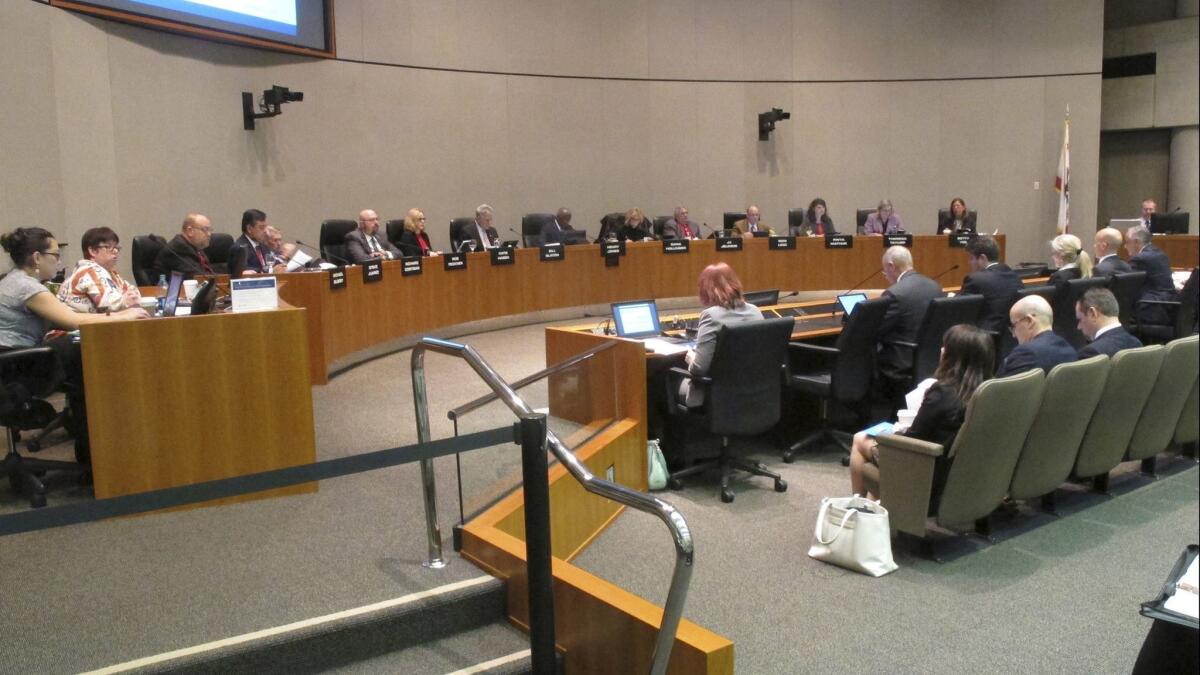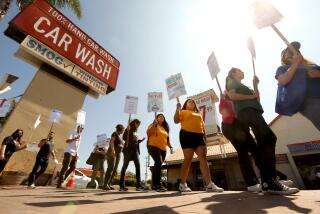Editorial: California’s Supreme Court takes cautious steps on public employee pensions

- Share via
Faced with rising obligations to current and retired public employees, the state of California and many local governments are pouring an increasing share of their tax dollars into pensions. Yet they still face a mountain of unfunded liabilities. The pension systems estimate that they are underfunded by $331 billion, according to the California Pension Tracker project at Stanford University, while many argue that the amount is several times higher.
The enormous shortfall helped persuade the state Legislature to pass public employee pension reform legislation proposed by Gov. Jerry Brown in 2012, reducing benefits for workers hired in the subsequent years and eliminating some of the tools current employees had used to pad their pension checks. Public employee unions quickly sued, accusing the Legislature of reducing benefits that should have been sacrosanct under longstanding state court precedents. Those precedents — collectively known as the California Rule — have essentially barred governments from cutting their current or former workers’ pension benefits for any reason.
For the record:
3:00 p.m. March 7, 2019This editorial erroneously states that CalPERS terminated benefits for employees at four local agencies that failed to make the required contributions to the pension fund. Actually, CalPERS terminated its contracts with the four agencies, causing their employees’ benefits to be deeply cut but not eliminated.
Several of the union lawsuits have been working their way up to the state Supreme Court, which delivered its ruling on the first of them Monday. Although the decision was modest and narrow, it struck the right balance between the interests of taxpayers, governments and public employees.
The courts need to find a way to safeguard reasonable pension benefits without making the excesses untouchable as well.
Grounded in a unique interpretation of the state and federal constitutions, the California Rule treats a public employee’s pension as a form of deferred compensation whose value is set the day the employee is hired. And, while the terms may be altered over time, the rule holds that the overall value can’t be diminished.
Under that principle, pensions can only be cut or eliminated prospectively, for workers not yet hired. In fact, some public employee unions argue that even those changes can’t be imposed unilaterally, but have to be negotiated. That’s why the Public Employee Pension Reform Act passed in 2012 largely nibbled around the edges of the pension funding problem, making changes that would take years to yield much in the way of savings.
One of those changes ended the “additional retirement service credit” (also known as air time) for any employee who hadn’t signed up for it by the end of 2012. For the previous nine years, public employees had been allowed to pay into their pension funds to gain credit for additional years of experience beyond what they had actually worked, thereby qualifying them for larger pensions. The payments were supposed to cover the cost of the increased benefits, but in practice they did not; a study by CalPERS found that the cost was underestimated by 12% to 38%. That gap made air time an unsustainable gift to public employees.
A group of Cal Fire employees and their union sued, arguing that cutting off access to air time reduced their pension benefits in violation of the California Rule. The Supreme Court disagreed, saying that air time wasn’t deferred compensation that workers had earned — rather, it was an optional way to increase their pensions. The state simply eliminated the option going forward while still honoring the deals already struck with employees who’d signed up.
In other words, the justices held that the California Rule wasn’t relevant to the issue at hand. In doing so, they ducked the larger question that some governmental employers had hoped they would address, which is whether the California Rule should be limited to benefits already accrued by current and former workers, or it should also cover benefits employees would earn for work not yet performed.
The stakes are huge, and we don’t fault the justices for being cautious. To their credit, they rejected the union’s overly expansive view of the California Rule. And there are three more cases in the pipeline that will examine how far the rule should reach.
Pensions are a key part of the compensation for police, firefighters and other public employees, and they need to be protected against shifting political winds. Once accrued, pension benefits should be inviolate. But the current system is tilted in a way that requires benefits to go in one direction only — up — for workers once they’re hired. That leaves public employers no way to recalibrate excessively generous pension commitments made in giddy boom times or by irresponsible elected officials.
Enter the Fray: First takes on the news of the minute »
Unsustainable pension promises can drive up taxes, force the elimination of government services and, potentially, bankrupt municipalities. And they can be bad for workers too. CalPERS, the pension fund for thousands of state and local employees, has terminated benefits for the employees of four local agencies in recent years after the agencies failed to keep up with their pension contributions. And a federal bankruptcy judge ruled in 2014 that local governments could slash their payments to CalPERS through the bankruptcy process, potentially reducing pension benefits.
The California Rule has helped protect public employee pensions against political changes or business cycles, and that’s welcome. But it has also been used to lock governments into deals that have proved unsustainable, irresponsible or too easy to game. The courts need to find a way to safeguard reasonable pension benefits without making the excesses untouchable as well.
Follow the Opinion section on Twitter @latimesopinion and Facebook
More to Read
A cure for the common opinion
Get thought-provoking perspectives with our weekly newsletter.
You may occasionally receive promotional content from the Los Angeles Times.









